This is a two-part series on gene editing in food plants. Part one can be found here. The article originally appeared in AFBF's FBNews
A new editing technology known as CRISPR has given researchers a more precise way to target a particular gene. (CRISPR is an acronym for an appallingly long description of certain DNA sequences: clustered regularly interspaced short palindromic repeats). It is easier and cheaper to use than other editing techniques.
By G.B. Crawford
A number of private firms have launched ventures to utilize the (CRISPR) technology. Corteva Agriscience, agriculture division of DowDuPont, has invested in CRISPR research for a number of row crops – especially corn and soybeans.
Senior Research Manager Bobby Williams said the company is moving forward with plans for a commercial pilot project with waxy corn. The research team has already developed an edited plant. Kernels of this corn contain high levels of amylopectin, a starch that can be used to thicken foods and make adhesives for labels.

Photo credit: Corteva
Waxy corn is primarily a Midwestern farm commodity. But Williams said gene editing may reinforce traits that allow it to thrive in other locations.
Researchers expect that consumers will benefit from gene-edited foods in the next decade.
He is optimistic that the technology will be widely applied to food crops. “I think there are a lot of opportunities when you get into the fruit and vegetable market,” Williams said. “Those are things that consumers can see and understand their benefits.”
A Durham, North Carolina-based firm, Pairwise, is applying CRISPR to row crops as well as fruits and vegetables. Haven Baker, the company’s chief business officer, said the “focus is to make noticeable improvements to the produce aisle. We’re trying to make produce more convenient, more affordable and possibly healthier.”
CEO Tom Adams pointed out that Pairwise is designed to operate as a food company. “The amazing, exciting opportunity that CRISPR brought was the ability to start doing things with crops that are in the consumer space,” Adams said.
He expects that it will have a large-scale impact on fresh produce by the mid-2020s.
The United States Department of Agriculture has expressed approval of gene-edited food plants. In 2018 Secretary of Agriculture Sonny Perdue announced that the agency “does not regulate or have plans to regulate plants that could otherwise have been developed through traditional breeding techniques.” Other agencies, such as the U.S. Food and Drug Administration, have not yet issued official positions.
Communication with Consumers
Researchers and agribusiness leaders acknowledge the obligation to communicate the value of the technology.
“I do believe that the products out there and the things that are nearing production on the market are safe to consume,” the University of California’s Jenkins said. “I would personally consume them.
“In the past we as scientists made the assumption wrongly that if we just got out and educated people about what we are doing, they would understand how safe this is, how practical it is and what our intentions are, it would be accepted,” she explained. “It is more about having a conversation with the consumer and what the consumer wants or needs.”
Haven Baker of Pairwise is confident consumers will be able to understand the benefits of this work because they will have access to the results in the grocery store.
“We think CRISPR will be one of the key tools of this century in meeting the needs of Florida and the rest of the world – to bring better foods to our markets,” Baker said.
G.B. Crawford is director of public relations for the Florida Farm Bureau.
